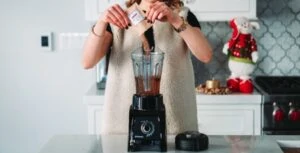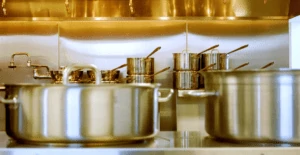These are the most important safe food handling tips that every home cook needs to know. Learn from experts and food professionals how to minimize germs, bacteria, and the risk of cross-contamination in your home kitchen.
Few things make us shudder like the thought of food poisoning. You know the symptoms (and we don’t need to get into the details now), but what causes it, exactly?
Food poisoning occurs when illness-producing bacteria get transferred (through cross-contamination) in 1 of 3 ways:
- From contaminated or raw food to other ready-to-eat food
- Contaminated equipment to food
- From sick or contaminated people to food
In almost every case, this bacteria is microscopic and totally invisible to the naked eye. So how can we avoid what we can’t even see?
For starters, presume everything and everyone that your food comes into contact with is contaminated or is a source of contamination. Yes, this is unappetizing thought, for sure. However, it’s always better to err on the side of caution!
In addition, adopt the following safe food handling tips and you can reduce the risk of illness, or in rare cases death, from food-borne illness, in a major way.
The Food Saftey Tips Every Home Kitchen Needs to Follow
To start, let’s review the Center for Disease Control’s (CDC) 4-part Keep Food Safe Campaign. The principles are: Clean, Separate, Cook, Chill.
Food Saftey Principle One: Clean
Good handwashing promotes overall health. So the first step is to clean your hands. This should be done frequently throughout the day and always before preparing food and before eating.
Be sure to wash your hands for at least 20 seconds under hot, soapy water. Do this before and after handling food and after using the bathroom, changing diapers, and handling pets.
In addition, practice the principle of clean by frequently washing kitchen and food preparation surfaces. Wipe up spills before they set and sanitize with disinfectant products. Also, regularly wash your cutting boards, dishes, utensils, and countertops with hot soapy water after preparing each food item. Consider using disposable paper towels to clean up kitchen surfaces. If you use cloth towels, launder them often in the hot cycle.
The Surfaces to Pay Attention to For Safe Food Handling at Home:
Refrigerator
When you want to get your fridge totally clean, empty it completely. This should happen at least once a month to reduce the risk of food spoilage. Be sure to throw out any expired and unwanted items. Then, remove any removable parts and thoroughly wash everything down with hot, soapy water.
Optional: Use a solution of 1 tablespoon of liquid bleach in 1 gallon of water to sanitize all of the fridge surfaces. Be sure to pay special attention to high-touch areas like door and drawer handles.
Pantry and cabinets
To keep these food storage areas safe and clean, clean them once a season. First, throw out expired items, donate unopened and unwanted items. Then label packages and cans with dates when you open them, so you know what needs to be consumed first.
Wipe down all surfaces with hot soapy water and a bleach solution if you like. Dry thoroughly before returning things to the cabinets.
Countertops
Declutter as best you can and keep clear of debris not related to cooking. Often-used appliances (a toaster, coffee maker, etc.) can stay. But everything else should be stored, donated, or thrown out.
Daily, wash all countertop surfaces thoroughly with hot soapy water. And if your countertop material recommends it, wipe it down with water/bleach (see above) if you need to sterilize. You certainly need to sanitize with a disinfectant after preparing raw meat, fish or seafood.
Trash cans
Here’s one that you may not clean very often, but is important to pay attention to! Every quarter (or whenever it smells like it needs a thorough cleaning), give your trash can some love.
Wash the bin inside and out with hot soapy water, as needed. Do not let your trash can overflow. Empty often.
Food Saftey Principle Two: Separate
This principle is all about keeping high-risk foods away from fresh and ready-to-eat products.
When grocery shopping, make a point of separating raw meat, poultry, seafood, and eggs from other items in the cart, grocery bags, and back home in your fridge.
Then, when you’re cooking at home, use one (easy-to-wash) cutting board for fresh produce and a separate one for raw meat, poultry, and seafood. Never place cooked food on a plate that previously held raw meat, poultry, seafood, or eggs unless the plate has been washed in hot, soapy water and sanitized completely.
Note: foods that pose the highest risk of contamination include leafy greens, bean sprouts, leftover rice, unpasteurized milk, soft cheeses, and deli meats, as well as raw eggs, poultry, meat, and seafood.
Food Saftey Principle Three: Cook
Next, pay attention to how your food is being cooked to ensure it’s free of potential harm.
Color and texture are unreliable indicators of food safety. Instead, a digital food thermometer will confirm whether meat and seafood has reached a safe internal temperature that is hot enough to kill harmful germs that cause food poisoning. Food thermometers also help avoid overcooking!
When in doubt, use a reputable guide like foodsafety.gov’s Safe Minimum Cooking Temperatures guidelines for minimum cooking temperatures and rest time for meat, poultry, seafood, and other cooked foods. A food thermometer is not needed just for meat and poultry. A safe minimum internal temperature must be reached to avoid food poisoning in all cooked foods. The “danger zone” for perishable foods is between 40° and 140° F.
Perishable foods are no longer safe to eat if they have been in this danger zone for more than two hours (one hour at 90° F or above). This is especially important to determine at buffets and potluck gatherings (see below regarding Gatherings and Events). When cooking in a microwave oven, cover the food, stir, and rotate for evenness. If there is no turntable, rotate the dish by hand. Always allow standing time, which completes the cooking, before checking the internal temperature with a food thermometer.
Food Saftey Principle Four: Chill
Finally, the temperature really matters! Always refrigerate fresh foods promptly and keep them chilled until you’re ready to cook them. Use an appliance thermometer to confirm the fridge temp is consistently 40° F or below and the freezer temp is 0° F or below.
Let’s talk leftovers & food safety
It is important to cover leftovers and store them in airtight packaging or sealed containers. Saving leftovers can cut your grocery bill in half and help you save money, but they must be saved correctly.
Leftovers can be kept in the refrigerator for 3 to 4 days or frozen for 3 to 4 months. If you have a large quantity, divide them into smaller containers for quicker cooling in the refrigerator.
When reheating leftovers in a microwave, always cover the food. Stir, rotate or flip it to ensure even heating. Use microwave-safe dishes and covers. Use a bit of water to add liquid, if needed. Vent the lid or wrap to let steam escape. The moist heat that is created helps destroy harmful bacteria and ensures uniform cooking.
When reheating sauces, soups, or gravy, bring them to a boil. Because microwaves have cold spots, check the temperature of the food in several places with a food thermometer and allow a resting time. Cooking continues for a longer time in dense foods such as a whole chicken or beef roast than in less dense foods like bread, small vegetables, and fruits.
Gatherings and Events
If you’re feeding a crowd, preparation and organization are key. Always store raw meat in a (very cold!) cooler or fridge. Maintain side dishes at low heat in the oven and keep cold platters in the refrigerator. Keep track of the time and discard perishables that have sat out for 2 hours at room temperature. Replace food with freshly cooked pieces, rather than adding to a platter that’s not yet empty.
Miscellaneous, but important
A few last tips to keep in mind for food safety at home:
- Never thaw food or marinate food at room temperature. Instead, always defrost food slowly and safely: in the refrigerator, in cold water, or in the microwave. Food thawed in cold water or in the microwave should be cooked immediately.
- Marinate in the refrigerator, not out on the countertop!
While food poisoning sucks(!), you can avoid many of its causes by following these safe food handling guidelines. These techniques also go a long way to promote healthy eating, avoid food waste, and help control expenses so you can enjoy meals and gatherings!
Sources
- USDA Basics for Food Handling Safety (March 24, 2015)
- Healthline: Bacterial Cross-Contamination: All You Need to Know (January 21, 2020)
- Healthline: E. Coli Infection (July 2, 2019)
- CDC: Four Steps to Food Safety: Clean, Separate, Cook, Chill (March 18, 2020)
- USDA: Leftovers and food safety (June 15, 2013)
- Academy of Nutrition and Dietetics: A Short Guide to Food Thermometers (August 2018)
- FoodSafety.gov: Four Steps to Food Safety (April 12, 2019)
- FoodSafety.gov: Food Safety by Type of Food (April 1, 2019)
- US Food and Drug Administration: Serving Up Safe Buffets (January 26, 2018)
- Five Common Ways Germs are Spread (January 23, 2019)
- Foodsafety.gov: Safe Minimum Cooking Temperatures Charts (April 12, 2019)











